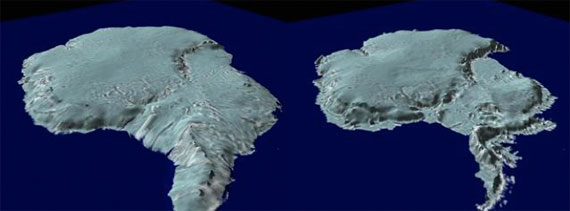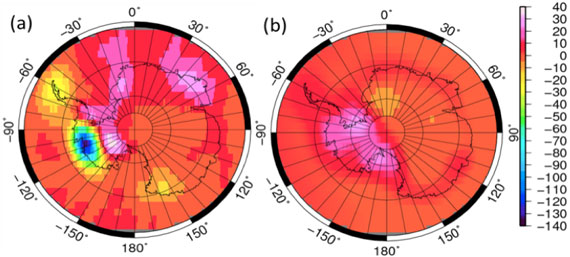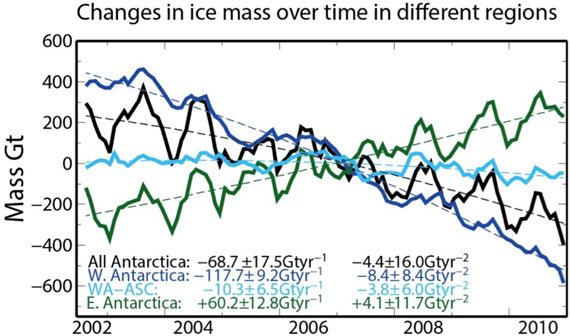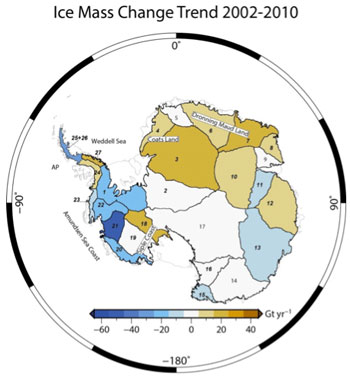Weighing change in Antarctica
Posted on 5 December 2012 by mattking
Guest commentary by Matt King, Michael Bentley and Pippa Whitehouse (expanded from a Real Climate posting)
Determining whether polar ice sheets are shrinking or growing, and what their contribution to changes in sea level is, has motivated polar scientists for decades. Genuine progress began in the early 1990s when satellite observations started to provide (nearly) spatially comprehensive sets of observations. Three very different, and hence complementary, approaches are now employed, although each has a particular limitation:
- Satellite altimetry: measurements of ice sheet volume changes from laser or radar altimeters (e.g. ICESat) can be converted to mass changes by accounting for the spatially- and temporally-varying surface density distribution together with spatial extrapolation to unsampled regions. The main limitation lies in the models used to correct for surface density changes.
- Input-minus-output: calculating the difference between the mass of snow accumulated and that of the ice (and meltwater) being discharged gives the mass imbalance. The snow accumulation is normally estimated from numerical models and the discharge is computed using the product of measured velocity at the edge of the ice sheet and measured or inferred ice thickness and density at this point. Thus, uncertainty in accumulation models and sub-glacial topography at the grounding line propagate into mass balance uncertainties.
- Satellite gravimetry: changes in Earth’s gravity field can be deduced from satellite data (e.g. from Gravity Recovery and Climate Experiment, GRACE) and used to determine changes in ice mass but only after accounting for mass-change effects that are not due to ice mass redistribution – in particular glacial isostatic adjustment (GIA).
The Gravity Recovery and Climate Experiment measures changes in Earth’s gravity field and hence movement of mass on, and within, the Earth
Our recently published Nature paper (King et al, 2012), used GRACE gravity data to infer Antarctic ice mass trends as in previous work, but with an updated estimate of the GIA correction. Most of the co-authors on our paper were also involved in a much larger study using all three techniques, with results reported in Science (Shepherd et al., 2012) in entirely in agreement with our estimate of Antarctic mass change.
But before we discuss results, what is GIA? When a large ice sheet grows in a location, such as happened at the Last Glacial Maximum (LGM) about 20,000 years ago, the weight of the ice deforms the solid Earth beneath it. Mantle material slowly flows away from beneath the ice sheet in an attempt to restore gravitational equilibrium – much like if you stand on wet sand you slowly sink as the sand flows away from beneath your weight. The more ice there is on top of the crust, the more the crust deforms. Because the density of the solid earth is approximately three-times greater than ice, 3 km of ice placed on the crust would eventually depress the crust beneath by about 1km. When the ice melts, as occurred following the LGM, the mass is transferred back to the oceans and the crust slowly moves back up and this creates a mass (and hence gravity) trend for many thousands of years.
Subtracting the GIA signal from GRACE data would not be a problem if we knew exactly how the ice sheets had changed in the past thousands of years and exactly how the Earth responds to such changes. However, we don’t. The greatest impediment is the uncertainty in reconstructing the post-LGM Antarctic ice sheet. Unlike the formerly-glaciated regions of the Northern Hemisphere, 98% of Antarctic bedrock remains covered by ice and the ice sheet edge is fringed by extensive ice shelves; this hampers the collection of data on ice history and introduces substantial uncertainty in reconstructions. Indeed, previous estimates of the extra volume of Antarctic ice at the LGM, compared to present-day, range from 3 to >30m of equivalent sea level (Bentley, 2010).

Figure 1: One reconstruction of how the Antarctic Ice Sheet changed from the LGM (left) to present (right), showing up to hundreds of metres of ice thinning. Credit: NASA/Goddard Space Flight Center Scientific Visualization Studio
Previous predictions of present-day GIA have implied that this process adds 100-200 Gt/yr to the GRACE signal over Antarctica; this must be subtracted from the raw GRACE data to reveal the rate of present-day ice-mass loss. This GIA correction is about as large as, or larger than, expected present-day ice-mass change. If the GIA model were to predict smaller GIA mass change, the GRACE estimate of ice mass change would be smaller by the same amount, so it’s clearly very important to have an accurate GIA model.
Over the last ten years, there has, however, been a big increase in field measurements that provide more constraints on both the ice history and present-day bedrock uplift, particularly in West Antarctica. New maps have been created of where ice did, and did not, exist at various periods. These data consistently show that the volume of ice in West Antarctica at the LGM was much less than previous data suggested, and less than that used in older reconstructions. Long ice cores from East Antarctica show accumulation increased there following the LGM until it levelled off a few thousand years ago. The long time required to discharge this extra snow into the ocean means that much of the East Antarctic ice sheet must be thicker now than at the LGM, with the exception being the coastal perimeter where the ice edge typically thinned and retreated following the LGM.
In our paper, we used our own ice-sheet reconstruction for the GIA correction. It suggests Antarctica has contributed ~8m to sea levels since the LGM – near the lowest estimates previously published. The resulting GIA model (called W12a) predicts much lower rates of uplift in West Antarctica than previous models. In East Antarctica it shows inland subsidence and coastal uplift.

Figure 2: The left panel shows the rate of ice+GIA mass change observed by GRACE, plotted in terms of the equivalent water thickness change (mm/yr) required to produce the observed signal. The right panel shows the predicted GIA signal from our new model. The ongoing flux of mantle material into areas which have experienced large-scale ice-mass loss since the LGM looks like mass gain to GRACE. The ice mass change is determined by subtracting changes in the right panel from those in the left. Credit: Phil Moore
These results can be tested directly against global positioning system (GPS) observations of bedrock uplift. These are measurements of how the Antarctic bedrock is moving vertically. The spatial distribution of sites is limited at present – because they need to be placed directly on rocky outcrops – and there are only a few such sites in East Antarctica. In addition, some of the West Antarctic GPS records are campaign-based rather than continuous and hence are less precise than we would like – although this is being tackled through the POLENET programme.
Nevertheless, GPS sites have systematically lower rates of uplift than previously predicted and our new GIA model (W12a) has much closer agreement than other GIA models.
So how does applying W12a affect estimates of ice mass change? The GRACE observations over Antarctica suggest a near-zero change due to combined ice and solid earth mass redistribution; the magnitude of our GIA correction is substantially smaller than previous models have suggested and hence we produce a systematically lower estimate of ice mass change from GRACE data: we estimate that Antarctica has lost 69±18 Gigatonnes per year (Gt/yr) into the oceans over 2002-2010 – equivalent to +0.19mm/yr globally-averaged sea level change, or about 6% of the sea-level change during that period. Our result still falls within the range of estimates produced from the other two independent techniques outlined above, but it is distinctly toward the lower end of the mass-loss range. Our estimate is about half to a third of the most recent estimates based on GRACE data.

Figure 3: Estimated ice mass change over time for the entire Antarctic ice sheet, West Antarctica, West Antarctica without the rapidly changing Amundsen Sea Coast (ASC) region and East Antarctica. Mean rates apply at year 2006.9. Accelerations are also shown in the right hand column, but are only significant in West Antarctica and can be narrowed down to being dominated by one glacier, Pine Island Glacier. All uncertainties are shown for the 95% confidence interval (2σ)
West Antarctica appears to be losing mass about twice as fast as the total rate, but this has been partially offset by recent East Antarctic snow accumulation.

Figure 4: map of our GRACE-estimated trends in ice mass with one estimate per major drainage basin (basin numbers are shown). The maps suggests growth of parts of coastal East Antarctica, little change in the interior and ice mass loss in West Antarctica (basins 18-27 and 1) focused on the Amundsen Sea Coast region (basins 20-23). AP is Antarctic Peninsula.
Despite the better fit to observations in our GIA model, significant uncertainties remain. We used an ensemble of ice sheet model runs and plausible Earth models to place bounded constraints on our mass change estimate. The East Antarctic rate of growth spans +7 to +89 Gt/yr – ranging between being effectively in balance to growing substantially. We need further field data from key areas of East Antarctica to reject some of the ice model scenarios – although there are fewer rock outcrops to sample geologically and geodetically in this region there are still large regions where outcrops exist but no, or few, data have been collected and/or results have been published.
The bounds in West Antarctica (loss of between 128 and 103 Gt/yr) reflect a much smaller GIA uncertainty together with a much small surface area. However, substantial ice sheet changes that occurred during the last hundreds to few thousands of years remain poorly quantified and are not included in our model. These may be particularly important in parts of West Antarctica, and particularly the Antarctic Peninsula, where mantle viscosity is estimated to be lower and hence more responsive to recent fluctuations in ice volume.
GRACE data are still being collected but the mission has now begun to rundown. With a much-needed GRACE follow-on mission being planned and expected to launch around 2017, observation and modelling of Antarctic GIA will continue to give us insights into the ice sheet history – from the LGM through to the present – and hence provide the context for any future changes.
Postscript: A grouping of 40+ scientists, including four of our Nature co-authors, participated in the NASA/ESA Ice Sheet Mass Balance Intercomparison project (IMBIE) in an attempt to understand the reasons for previously disparate ice mass change estimates. IMBIE reported results for Greenland and Antarctic ice mass changes for the last two decades in Science (Nov 30, 2012). The GRACE estimates for Antarctica used in that study were not our own and were based on a mean of W12a and an alternative new GIA model. The mass change estimate for Antarctica is entirely in agreement with ours for a similar period. While the introduction of our Nature paper highlights the lack of consensus in studies published prior to October 2012, the community has reconciled most of the previous differences through the IMBIE study. Both studies highlight the need for further improvements to Antarctic GIA models, however.
References
M.A. King, R.J. Bingham, P. Moore, P.L. Whitehouse, M.J. Bentley, and G.A. Milne, "Lower satellite-gravimetry estimates of Antarctic sea-level contribution", Nature, 2012.
http://dx.doi.org/10.1038/nature11621
M.J. Bentley, "The Antarctic palaeo record and its role in improving predictions of future Antarctic Ice Sheet change", Journal of Quaternary Science, vol. 25, pp. 5-18, 2010.
http://dx.doi.org/10.1002/jqs.1287
Shepherd, A., E.R. Ivins, G. A, V.R. Barletta, M.J. Bentley, S. Bettadpur, K.H. Briggs, D.H. Bromwich, R. Forsberg, N. Galin, M. Horwath, S. Jacobs, I. Joughin, M.A. King, J.T.M. Lenaerts, J. Li, S.R.M. Ligtenberg, A. Luckman, S.B. Luthcke, M. McMillan, R. Meister, G. Milne, J. Mouginot, A. Muir, J.P. Nicolas, J. Paden, A.J. Payne, H. Pritchard, E. Rignot, H. Rott, L.S. Sørensen, T.A. Scambos, B. Scheuchl, E.J.O. Schrama, B. Smith, A.V. Sundal, J.H. van Angelen, W.J. van de Berg, M.R. van den Broeke, D.G. Vaughan, I. Velicogna, J. Wahr, P.L. Whitehouse, D.J. Wingham, D. Yi, D. Young and H.J. Zwally, "A Reconciled Estimate of Ice-Sheet Mass Balance", Science, vol 338(6111), pp 1183-1189, 2012.































 Arguments
Arguments























 0
0  0
0






Comments